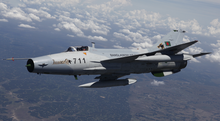 |
| Mikoyan-Gurevich MiG-21 |
| MiG-21 | |
| National origin | Soviet Union |
| Entered service | 1972 |
| Crew | 1 men |
| Dimensions | |
| Length | 15.76 m |
| Wing span | 7.15 m |
| Height | 4.1 m |
| Weight (empty) | 5.46 t |
| Weight (maximum take-off) | 10.1 t |
| Engines info | |
| Engines | 1 x R-25-300 turbojet |
| Traction (dry / with afterburning) | 40.2 / 67.2 kN |
| Maximum speed | 2 230 km/h |
| Cruising speed | 1 000 km/h |
| Service ceiling | 19 km |
| Range | 1 225 km |
| Range (with external fuel tanks) | 1 470 km |
| Combat radius | 370 km |
| Armament | |
| Cannon | 1 x 23 mm GSh-23L (200 rounds) |
| Missiles | R-3 (K-13), R-13M (K-13M), R-60, R-60M air-to-air missiles, Kh-66 air-to-surface missiles |
| Bombs | various bombs, including general-purpose, fragmentation, chemical and cluster with a maximum weight of up to 1 000 kg |
| Other | pods with 57 mm or 240 mm unguided rockets |
Mikoyan-Gurevich MiG 21 is a fighter jet. Mikoyan Design Bureau designed the MiG 21 aircraft(NATO codename is Fisbed). The MiG 21 was born in the Soviet Union. It is the most-built fighter jet in history. It was popularly known as Malaika.
Its predecessor was the MiG 19, which was primarily a ground attack fighter. In 1948-49, the Soviets completed the design of a supersonic fighter aircraft consisting of the MiG-17, MiG-19 and Sukhoi-7. After test flights of the MiG-21, the Soviets realized that the engine was underpowered for the fighter, and another prototype was built to correct this problem. This prototype also failed due to wing problems. Their testing prototype also fell into the same situation. Finally, on 16 June 1955, the final prototype was approved for final production, and the fighter entered service in 1959. Later, this aircraft was added to the Air Force fleet of Soviet Russia. Americans knew nothing about it before 1959, but they learned about it during the Vietnam War.
The MiG 21 is a supersonic fighter. It is effective from sky to sky, sky to ground. MiG 21 has powerful engine and light body. Also, advanced maneuvering power set this fighter apart from other fighters. The maintenance cost of MiG 21 is quite low. This aircraft does not require a separate shed. This aircraft can be left under the open sky.
50 years after entering service in 1959, the MiG 21 and its Chinese version, the J-7 / F-7 Air Guard, are still in use in nearly 50 countries around the world. The main reason is its advanced version. Except for the body of this fighter, almost all the parts have been more or less improved. And these upgrades have helped keep this fighter modern.
 |
| upgraded variant F/J-7 |
- Year-by-year kill claims involving MiG-21
- 1966: U.S. claimed six MiG-21s destroyed; North Vietnam claimed seven F-4 Phantom IIs and 11 F-105 Thunderchiefs shot down by MiG-21s.
- 1967: U.S. claimed 21 MiG-21s destroyed; North Vietnam claimed 17 F-105 Thunderchiefs, 11 F-4 Phantom IIs, two RF-101 Voodoos, one A-4 Skyhawk, one Vought F-8 Crusader, one EB-66 Destroyer and three unidentified types shot down by MiG-21s.
- 1968: U.S. claimed nine MiG-21s destroyed; North Vietnam claimed 17 US aircraft shot down by MiG-21s.
- 1969: U.S. destroyed three MiG-21s; one Ryan Firebee UAV destroyed by a MiG-21.
- 1970: U.S. destroyed two MiG-21s; North Vietnam claimed one F-4 Phantom and one CH-53 Sea Stallion helicopter shot down by MiG-21s.
- 1972: U.S. claimed 51 MiG-21s destroyed; North Vietnam claimed 53 US aircraft shot down by MiG-21s, including two B-52 Stratofortress bombers. Soviet General Fesenko, the main Soviet adviser to the North Vietnamese Air Force in 1972,recorded 34 MiG-21s destroyed in 1972.
Specification
- Crew: 1
- Length: 14.7 m (48 ft 3 in) excluding pitot boom
- Wingspan: 7.154 m (23 ft 6 in)
- Height: 4.1 m (13 ft 5 in)
- Wing area: 23 m2 (250 sq ft)
- Airfoil: root: TsAGI S-12 (4.2%);
- Gross weight: 8,725 kg (19,235 lb) with two R-3S missiles
- Max takeoff weight: 8,800 kg (19,401 lb) unprepared or metal planking runway
- 9,800 kg (21,605 lb) paved runway with standard wheels and tyres
- 10,400 kg (22,928 lb) paved runway with larger wheels and tyres
- Powerplant: 1 × Tumansky R-25-300 afterburning turbojet, 40.18 kN (9,030 lbf) thrust dry,69.58 kN (15,640 lbf) with afterburner
Performance
- Maximum speed: 2,175 km/h (1,351 mph, 1,174 kn) / M2.05 at 13,000 m (43,000 ft)
- 1,300 km/h (810 mph; 700 kn) / M1.06 at sea level
- Landing speed: 250 km/h (160 mph; 130 kn)
- Range: 660 km (410 mi, 360 nmi) clean at 11,000 m (36,089 ft)
- 604 km (375 mi; 326 nmi) at 11,000 m (36,089 ft) with two R-3S missiles
- 793 km (493 mi; 428 nmi) at 10,000 m (32,808 ft) with two R-3S missiles and 800 l (210 US gal; 180 imp gal) drop-tank
- Service ceiling: 17,500 m (57,400 ft)
- Time to altitude: 17,000 m (55,774 ft) in 8 minutes 30 seconds
- Thrust/weight: 0.76
- Take-off run: 830 m (2,723 ft)
- Landing run with SPS and brake parachute: 550 m (1,804 ft)
Armament
- Guns: 1 × internal 23 mm Gryazev-Shipunov GSh-23L autocannon with 200 rounds
- Hardpoints: 5 (4 underwing + 1 ventral, reserved for fuel droptanks) , with provisions to carry combinations of:
- Rockets: 4 × S-24 or 4× UB-16-57 rocket pods (4×16 57mm rockets)
- Missiles: Air-to-air missiles:
- K-13
- R-55











0 Comments